ENGINE TEMPERATURE
TROUBLES
from Robin King's Column June 1973 FORMAT,
the newsletter of the Morgan Plus 4 Club
Normal operating temperature for your engine is about
75 C. If you are running colder, you are losing efficiency, and if it is
appreciably hotter, you can get into trouble.
If your engine runs too hot consistently and overheats
or boils on a slight grade or on a hot day, there are several possible
causes. The first things to check are the most obvious and the easiest.
First be sure there is an unobstructed flow of the air to the radiator.
The central location of the fog light, as furnished on most Morgans, is
a major contribution to overheating in this area. Bc sure your radiator
passages are not full of bugs and dirt. Clean then out with a hose
from the back. From this, go to your water system. Start by checking the
condition ot the water in your cooling system. If it is full of rust and
dirt, drain and flush the system until you are sure it is clean. If it
is excessively dirty, it is a good idea to have the radiator back flushed
to be sure. Next, look for leaks around and under the radiator, at various
hose connections and around the water pump and petcock on the engine block.
When checking the hoses, be sure they are not soft when you squeeze them.
A hose may look O.K. on the outside but can have a loose flap or blister
on the inside restricting the water passage.
If everything is OK so far, check the fan belt to be sure
it is in good condition and not slipping. The next step is to check the
water pump and thermostat. Remove the radiator pressure cap and rev up
the engine. If the water pump is working properly and the thermostat is
not stuck closed, you will see a turbulent condition on the surface of
water. If the water remains still, it is usually a bad thermostat
since pump failures are relatively rare.. Remove the thermostat and repeat
this test to check the pump itself.
If your engine still won't run cool., start checking the
fuel mixture and check for leaks around the induction system. If your carburetors
are set too lean, or are excessively dirty, they will cause hot running.
Check all the joints in the manifold (intake system) by smearing a little
engine oil on the joints (one at a time) and rev up the engine. If your
exhaust shows blue smoke, you have a leak and should tighten the joint,
or replace the gasket.
Another common cause of overheating is retarded ignition.
This can be due to poor timing or sticking of the automatic advance/retard
mechanism at the base of the distributor. The vacuum advance can cause
this by a leak in the diaphragm too. I have found that this retarded
ignition is quite a common situation. Many mechanics will set an engine
slightly retarded if the customer complains of pinging. Usually it
is caused by lugging the engine at too low revs.
Another contribution to a hot engine can be an oil
which does not have enough viscosity index or will foam, and lose its conductivity
accordingly. If you do a lot of stop and go driving, it pays to use a premium
quality multi-grade oil. If you have been using a 20 wt., use a 10-30,
if you have been using a 30 wt., go to a 20-40.
If you have done all the proceeding and still have
a hot running engine, start looking for burned valves warped head, and
other major problems.
REDUCING HEAT IN THE CABIN
by Lorne Goldman
1. Reducing Engine Bay Temperatures: If you lower the engine bay temperatures, that will help
both you and the engine. This can done by reducing the engine and exhaust
heat. The engine can be done by assuring yourself it is tuned properly
(see other articles on this subject and your model)
2. Reduce the Heat from Exhaust.
The latter can be done
by ceramic coating the manifolds. Please read the articles in this Manual's
Exhaust
section.
 |
WATCHPOINT:
In the newer Morgans, the gearbox covers are badly designed (severely
reducing cabin footwell space for no fathomable reason aside from ease
of manufacture)
but well heat-insulated. I added to this protection by having the Factory make my gearbox and
propshaft foam one size thicker. I also made sure there was an foolproof air blockage
around the gear lever.) However, even in these newer Morgans there is still heat radiating from the gear lever, the propshaft (adjacent to the
passengers) and the radiant heat from the heater matrix
over the foot compartment! No wonder Morgan owners of Morgans made in the last 15-20 years want AC these days. It is sad that to think that earlier Morgan inhouse designers could figure out what current designers cannot. |
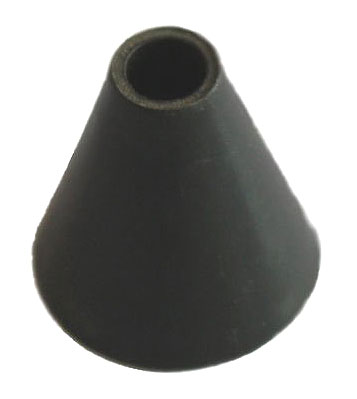 |
3. Gearbox Cover
Much
of the heat in the cabin comes from the gearbox, propshaft and gear
lever and the firewall, in this orderl. The easiest (and most expensive
way) of curing the gearbox
cover heat is to have a new cover made and have it lined with 1/2 inch
of foam rather than the horsehair of 1/4 inch foam used by the Factory.
Another method is to remove the metal gearbox cover,
and insulate them from the inside if there is sufficient space to do
so. This is what the Works has done since the late-1990s.
4. Propshaft Cover. Insulate from the inside.
MAKING A MORGAN FOOT VENT
An excerpt from Robin King's Column
June 1972 FORMAT, the newsletter of the Morgan
Plus 4 Club
Ventilation: Ah ha! you ask does a Morgan need more
ventilation?
Yes, most assuredly, at least in hot weather. Have you forgotten your feet?
On a hot day, with a hot engine (perhaps even overheated) don't you feel
like you are feet-first in the Witches oven?
My remedy...foot air vents, and the really do make a difference.
I had a devil of a time locating a place to put holes without seeking engine
heat or chopping up the exterior. After several inspections, voila!, there
is a spot about 2 inches from the firewall and 6 inches off the floor.
Perfect! It comes out above the Z section into the fender flashing and
on the outside, hidden from view under the fender.
Fresh air flows alongside the frame and into the vent
and onto your feet. The hole I made in mine is about 1 1/2 inches in diameter.
For cooler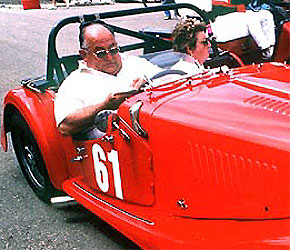 weather, I have made a sliding gate that closes the opening.
There now, for you creatures that desire small measures of comfort, try
some of these ideas. Every little bit helps.
weather, I have made a sliding gate that closes the opening.
There now, for you creatures that desire small measures of comfort, try
some of these ideas. Every little bit helps.
ENTERING AND EXITING A MORGAN
by Lorne Goldman
One
of the most basic problems encountered by prospective purchasers, new
owners
and even old ones is how to enter and exit a truly classic Morgan (aka a
"trad") without cracking the dash, breaking a leg or losing a
knee cap.
No levity intended. So often, this simple task prejudices the first impression
of the car..or becomes increasingly difficult for the less agile, the aged or the
longer limbed. Of course, the Morgan trad is not ideal for an obese person
(tho plump is ok)...but these souls now have the Aero range (Series II and
later) which are friendlier for very heavy moggers.
N.B. The long door versions (a Charles Morgan initiative) helps only a tiny but not because the doors are longer (longer doors do not change the length of seats and the entry space the seats block). The long door cars created more space between the steering wheel and the seat for larger tummies. Do do so Charles
sacrificed
the leather sill under the windscreen which contained the de mister
vents byt this allowed the steering wheel
to be pushed forward. However, this post-1996 was not worth the
effort. It began a sad domino effect which only the besotted can't see.
1. without the sill, there is an important padded gripping spot that acted as aid
to drivers and passengers entering and exiting.
2. without the sill, there is no space for demister vents.
Without demister vents, Morgan had to resort to odd Morgan-only heated
windscreens, at a cost of (in 1996) £1000 more (versus 50£ of easily
findable
school bus glass (See Replacing
Morgan Windscreens)
As flat glass is fragile and pits quickly, Morgan windscreens should be
a regular replacement item so this a big problem area, or a
vacation-killer when travelling. Many owners have
taken to foregoing the newer demisting system when replacement is
required. |
Entering a Classic CAN be done gracefully. There is a
trick to it. There IS also a list of DO NOTS!
DO NOT:
1. Do not enter the car as you would others, by bending
your inboard knee. The poor knee will encounter the dash or the steering
wheel and inevitably crack or snap them. As well, the regular pressures
of entering that way commonly destroys the collapsible column bush which
leaves the steering wheel with fore and aft movement which is unacceptable
and unsafe. Unless you have the skill to replace that bush, (Replacing
the Steering Column Bush) you will require a new column assembly
and for many cars, that new columns are NOT an easy retro-fit and a bill
can run into 1000s.
2. Do not hold the dash when exiting the car, you will
eventually crack it.
3. Do not hold the windscreen frame when exiting. Maurice
Owen (Morgan's chief designer for many years and a large man) was infamous
for doing that and requiring a number of windscreen replacements each year.
HOW TO DO YOU DO IT?
ENTER
1. Open the door (duh!)
2. Place your outboard hand on the close end of the leather
dash bumper and your inboard hand on the top outboard corner of the seat.
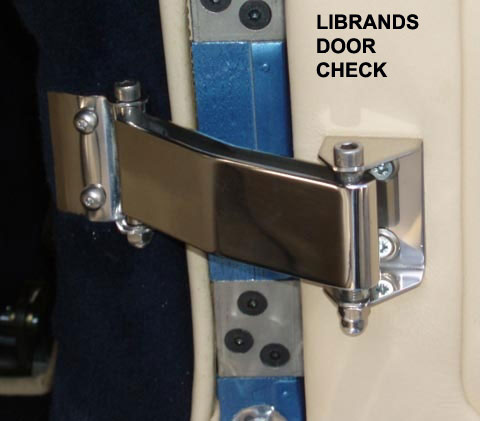 3.
Extend your inboard leg into the foot well under the dash while swivelling your
rump inward over the seat.
3.
Extend your inboard leg into the foot well under the dash while swivelling your
rump inward over the seat.
4. Fall into the seat
Essentially. you will purposely unbalance yourself and
fall gracefully into the seat without damaging steering wheel or dash.
EXIT
This requires strength in your outboard leg.
1. Open the door. (If it falls closed and that stops you
from an easy exit, you can try tightening the hinges or (carefully) respace
the hinge spacers to correct that. Librands also sells doors checks that
cure the issue. )
2. Grasp the same end area of the dash bumper you did when entering. THIS is the strongest area of that bumper..
3. Place your outboard leg outside of the car on the ground
and use it to lever yourself out of the car.
PROPERLY PUTTING ON THE SIDESCREENS
by Lorne Goldman November 2011
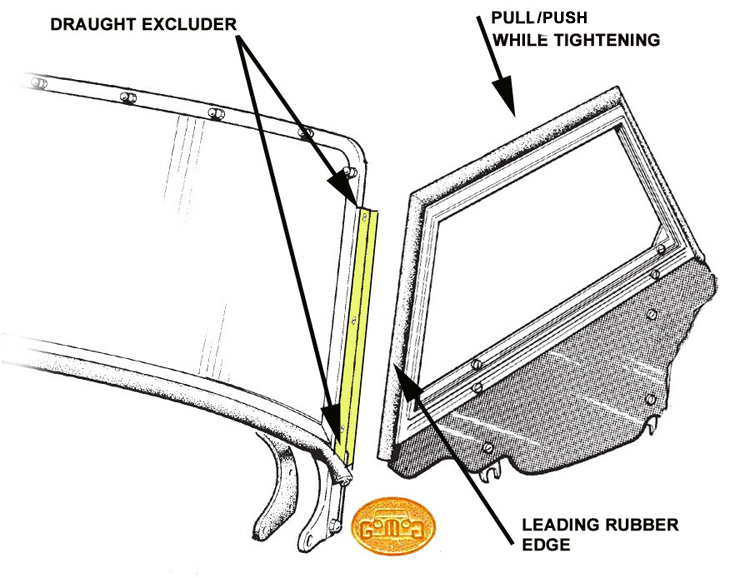 For
the first few years of Morgan ownership, my sidescreens kept me frustrated,
especially in the rain. The screens would tilt outboard, leaving a space
between their leading edge rubber molding and the draught excluders (the
items attached to the ends of windscreen side pillars that are supposed
to block the wind and rain from getting past the sidescreens). But with
any space between the leading edge and the excluders, the rain and the
wind enter the cabin at speed, making driving unpleasant. I tried a number
of solutions, even bending the sidescreen supports in an effort to have
them cant inboard at the front and top. N.B. Don't bother trying this.
It simply arcs the supports and does not address the problem and can make
it worse.
For
the first few years of Morgan ownership, my sidescreens kept me frustrated,
especially in the rain. The screens would tilt outboard, leaving a space
between their leading edge rubber molding and the draught excluders (the
items attached to the ends of windscreen side pillars that are supposed
to block the wind and rain from getting past the sidescreens). But with
any space between the leading edge and the excluders, the rain and the
wind enter the cabin at speed, making driving unpleasant. I tried a number
of solutions, even bending the sidescreen supports in an effort to have
them cant inboard at the front and top. N.B. Don't bother trying this.
It simply arcs the supports and does not address the problem and can make
it worse.
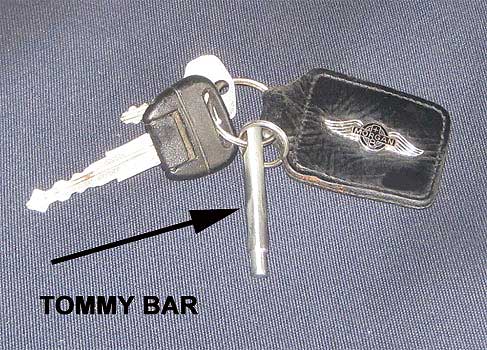
After a couple of years of mogging, I found there is
a simple trick that solves the problem. Like most solved problems, it become
second nature and I didn't think of it again until I read of other solutions
on Morgan internet forums involving bungee cords, towels, wider rubber
moldings and/or special brackets. It is those errors that precipitated
this article.
You see, the two sidescreen fasteners are on a single
plane. That means that there is a large amount of variance to how the sidescreen
can be angled. Very often, the wrong angle will leave a large open space
for unwanted rain and wind. To get an angle that will have the rubber molding
hugging behind the protection of the draught excluders, simply pull the
top of the sidescreen inward as you tighten the fasteners. Then, when you
have the angle you want, tightened the fasteners with a tommy bar. That
is what the little holes in the fasteners are for. You will find the tommy
bars are more than a little item from yesteryear, they are a basic Morgan
tool. Buy one that slips onto your Morgan key fob. Drive dry. I do.
BACK


 weather, I have made a sliding gate that closes the opening.
There now, for you creatures that desire small measures of comfort, try
some of these ideas. Every little bit helps.
weather, I have made a sliding gate that closes the opening.
There now, for you creatures that desire small measures of comfort, try
some of these ideas. Every little bit helps.

 For
the first few years of Morgan ownership, my sidescreens kept me frustrated,
especially in the rain. The screens would tilt outboard, leaving a space
between their leading edge rubber molding and the draught excluders (the
items attached to the ends of windscreen side pillars that are supposed
to block the wind and rain from getting past the sidescreens). But with
any space between the leading edge and the excluders, the rain and the
wind enter the cabin at speed, making driving unpleasant. I tried a number
of solutions, even bending the sidescreen supports in an effort to have
them cant inboard at the front and top. N.B. Don't bother trying this.
It simply arcs the supports and does not address the problem and can make
it worse.
For
the first few years of Morgan ownership, my sidescreens kept me frustrated,
especially in the rain. The screens would tilt outboard, leaving a space
between their leading edge rubber molding and the draught excluders (the
items attached to the ends of windscreen side pillars that are supposed
to block the wind and rain from getting past the sidescreens). But with
any space between the leading edge and the excluders, the rain and the
wind enter the cabin at speed, making driving unpleasant. I tried a number
of solutions, even bending the sidescreen supports in an effort to have
them cant inboard at the front and top. N.B. Don't bother trying this.
It simply arcs the supports and does not address the problem and can make
it worse.
